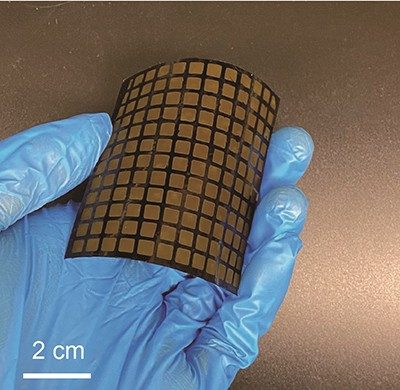FOR IMMEDIATE RELEASE
ACS News Service Weekly PressPac: August 04, 2021
Flexible, wearable X-ray detector doesn’t require heavy metals
“Flexible Lead-Free X-ray Detector from Metal-Organic Frameworks”
Nano Letters
X-ray imaging is a fast and painless way for doctors to see inside a person. But radiation detectors, which go under the body part being imaged, are rigid panels that contain harmful heavy metals, such as lead and cadmium. Now, researchers in ACS’ Nano Letters report a proof-of-concept wearable X-ray detector prepared from nontoxic metal-organic frameworks (MOFs) layered between flexible plastic and gold electrodes for high-sensitivity sensing and imaging.
Most X-ray detectors are integrated into big, immobile instruments, such as computerized tomography (known as CT) and mammography equipment, or are stiff, like the sharp-edged bitewing detectors used in dental offices. Detectors that could conform to rounded body parts or mold to the inside of confined spaces could be beneficial in some radiation monitoring and medical imaging applications. Previous researchers have used MOFs for flexible radiation detectors because they are semiconducting materials that respond to electromagnetic radiation by creating an electrical current. However, some of these MOFs still include lead, just like the X-ray detectors that are currently in use. So, Shuquan Chang, Shenqiang Ren and colleagues wanted to create a heavy-metal-free MOF for a flexible X-ray detector and imager.
The researchers mixed a solution of nickel chloride salt and 2,5-diaminobenzene-1,4-dithiol (DABDT) for several hours, creating a MOF in which nickel linked the DABDT molecules. In initial tests, the nickel-containing MOF was more sensitive than recently reported detectors when irradiated with 20 keV X-rays, equivalent to the energy released during medical diagnostic imaging. Then, to make a flexible X-ray radiation detector, the team sandwiched the nickel-containing MOF between gold film electrodes, one of which was on a flexible plastic surface. They used copper wires to transmit current from each pixel of a 12x12 array and covered the whole device with a silicone-based flexible polymer. Finally, they placed an aluminum letter “H” on the detector and irradiated it with X-rays, measuring a much lower current output underneath the H than under the unimpeded material. The researchers say that their proof-of-concept device is promising for the next generation of radiology imaging equipment and radiation detection when wearable or flexible devices are needed.
The authors acknowledge funding from the National Natural Science Foundation of China, Aeronautical Science Foundation, PAPD (A Project Funded by the Priority Academic Program Development of Jiangsu Higher Education Institutions) and China Scholarships Council.
###
The American Chemical Society (ACS) is a nonprofit organization chartered by the U.S. Congress. ACS’ mission is to advance the broader chemistry enterprise and its practitioners for the benefit of Earth and all its people. The Society is a global leader in promoting excellence in science education and providing access to chemistry-related information and research through its multiple research solutions, peer-reviewed journals, scientific conferences, eBooks and weekly news periodical Chemical & Engineering News. ACS journals are among the most cited, most trusted and most read within the scientific literature; however, ACS itself does not conduct chemical research. As a leader in scientific information solutions, its CAS division partners with global innovators to accelerate breakthroughs by curating, connecting and analyzing the world’s scientific knowledge. ACS’ main offices are in Washington, D.C., and Columbus, Ohio.
To automatically receive press releases from the American Chemical Society, contact newsroom@acs.org.
Note: ACS does not conduct research, but publishes and publicizes peer-reviewed scientific studies.
Media Contact
ACS Newsroom
newsroom@acs.org
View the image


